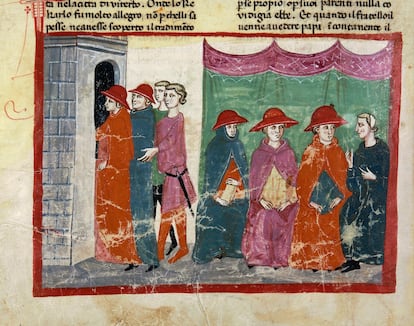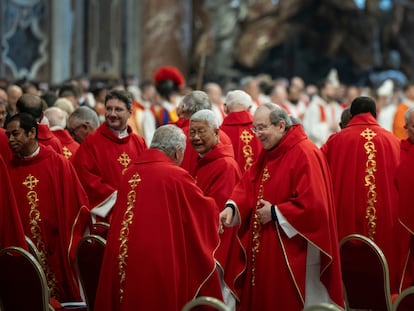How to elect a pope in the Middle Ages: Violence, scandals, and the first conclave in 1274
The study of medieval chronicles highlights the traumatic impact of electing the Bishop of Rome

Any baptized male can become pope. This simple principle stands out when addressing the survival of an institution whose reproduction does not depend on family succession. Medieval sources, however, describe the trauma that seating someone on the throne of Saint Peter entailed every few years — or months in particularly turbulent times. Papal elections in the Middle Ages were anything but orderly and predictable.
Some were decided by acclamation, others as a result of violent conflicts (that of Pope Damasus in the 4th century ended with 120 corpses in the streets of Rome in just one afternoon), others occurred within powerful Roman families who passed the office from father to son, some were imposed by lay rulers, others ended with popes and antipopes exercising power simultaneously.
When the German Emperor Henry III arrived in Rome to be crowned in 1046, he found himself faced with three popes. He deposed them all and installed a new one. History has sanctioned as legitimate popes those who won in battle and in the narrative, regardless of how the victory came about.
The primacy of the Bishop of Rome was consolidated over time, not without controversy, because the tradition of the apostles Peter and Paul survived there. At the end of the 4th century, he began to be called pope to distinguish him from all others. He was still theoretically appointed by the Roman community and consecrated by other bishops, but the election was always determined — depending on the various circumstances — by the balance or confrontation between factions of the clergy, the influence of the Roman nobility, the influence of family ties of some candidates or others, as well as by the pressure of political powers, particularly the emperors, whether Byzantine, Carolingian, or Germanic.
The Liber Pontificalis, a compilation of the lives of the popes written between the 6th and 9th centuries, reveals an almost incomprehensible range of cases and the particular instability of the papacy between the 7th and 9th centuries. It records pontificates lasting between 10 and 20 days, the acclamation of a member of the Roman aristocracy by the army as if he were an emperor, uncertainty during long periods of the seat lying vacant, depositions, and violent confrontations.
In the 10th century — the Iron Age of the papacy as many authors considered — few elections ended well. Propagandists of the Protestant Reformation in the 17th century exploited the excesses of a century they described as a papal pornocracy, amplifying the legend of the existence of Pope Joan, who was said to have passed herself off as a man, occupied the throne for two years, and died in childbirth in the middle of a procession.
In 100 years, there were 30 popes and antipopes; half of them died violently. There is evidence of an 18-year-old pope (John XII), of another who murdered his two predecessors (Sergius III), and of the so-called Cadaver Synod, the trial of the mummy of Pope Formosus, who, once condemned, was stripped of his papal insignia, mutilated, and thrown into the Tiber.
In April 1059, a decree by Nicholas II established that only cardinals could elect the pope, and that lay people were excluded. Other rules were established that were not always respected, such as the two-thirds qualified majority that remains in effect today.
The first confinement of cardinals occurred in 1198, at the time of the election of Innocent III. Upon the death of Gregory IX in 1241, the cardinals were confined to the Septizonium, at the foot of the Palatine. Many cardinals fell ill, and one died. According to the biographer of the future Innocent IV, food was scarce and sanitary conditions disastrous.
The death of Clement IV (1268) opened a 33-month period of sede vacante, the longest in history. Once the cardinals were installed in the palace at Viterbo, endless discord reigned among them. The desperate city dwellers then forced a solution by locking the cardinals up. A pope, Gregory X, was then elected.
Perhaps the traumatic nature of the election process led Gregory X to promulgate the bull Ubi periculum at the Second Council of Lyon in 1274, which established the method of election and defined the conclave. Ten days after the pope’s death, the cardinals were to meet in the papal palace, where they were locked in (cum clavis) and forced to live together. The bull stipulated that the camerlengo would guard the keys and that, as a form of pressure, from the third day of confinement the cardinals would be deprived of food and drink.
Despite the importance for the future of the pontifical institution, few subsequent elections followed the decree. The establishment of the papacy in Avignon for more than 70 years and the so-called Western Schism, with its two sees, Rome and Avignon, each with its popes and antipopes and curias, revealed the enormous difficulty of regulating papal elections. The Council of Constance in 1415 ended the schism. The last Avignon pope, the Aragonese Benedict XIII, was deposed in 1417. The sede vacante was then declared, as so often after.
Ana Rodríguez is a Research Professor in the Department of Medieval Studies at the CSIC History Institute.
Sign up for our weekly newsletter to get more English-language news coverage from EL PAÍS USA Edition
Tu suscripción se está usando en otro dispositivo
¿Quieres añadir otro usuario a tu suscripción?
Si continúas leyendo en este dispositivo, no se podrá leer en el otro.
FlechaTu suscripción se está usando en otro dispositivo y solo puedes acceder a EL PAÍS desde un dispositivo a la vez.
Si quieres compartir tu cuenta, cambia tu suscripción a la modalidad Premium, así podrás añadir otro usuario. Cada uno accederá con su propia cuenta de email, lo que os permitirá personalizar vuestra experiencia en EL PAÍS.
¿Tienes una suscripción de empresa? Accede aquí para contratar más cuentas.
En el caso de no saber quién está usando tu cuenta, te recomendamos cambiar tu contraseña aquí.
Si decides continuar compartiendo tu cuenta, este mensaje se mostrará en tu dispositivo y en el de la otra persona que está usando tu cuenta de forma indefinida, afectando a tu experiencia de lectura. Puedes consultar aquí los términos y condiciones de la suscripción digital.
More information
Archived In
Últimas noticias
The impact of Ecuador’s mega-prison: A polluted river, cleared forests and military checkpoints
Corinne Low: ‘I’m more concerned about the female happiness gap than the gender wage gap’
Trump traveled on Epstein’s plane ‘many more times’ than previously thought, according to new documents
Venezuelan exiles in Madrid scramble to salvage Christmas plans after flight cancellations
Most viewed
- The low-cost creative revolution: How technology is making art accessible to everyone
- Christian Louboutin: ‘Young people don’t want to be like their parents. And if their parents wear sneakers, they’re going to look for something else’
- All the effects of gentrification in one corner of Mexico’s Colonia Roma
- Liset Menéndez de la Prida, neuroscientist: ‘It’s not normal to constantly seek pleasure; it’s important to be bored, to be calm’
- Christmas loses its festive spirit: ICE fears cast shadow over religious celebrations










































